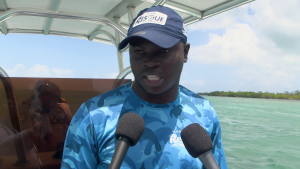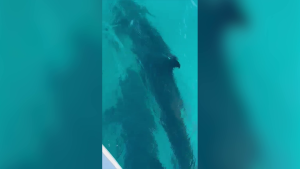No False Killer Whales Spotted, But Dolphins in Love
On Tuesday, around thirty false killer whales were spotted inside the Belize Barrier Reef system, raising concerns among marine biologists that the creatures might be lost and stranded. These dolphins, named for their resemblance to killer whales, typically live in the deep blue sea but occasionally appear in our waters, as they did in 2018 and 2024. Fortunately, both times they managed to find their way back without any casualties. Today, two marine biologists ventured offshore near Belize City, hoping to locate the school of false killer whales. The good news? There was no sign of them, giving the biologists hope that the whales have safely navigated back to their natural habitat.
 Marion Ali, Reporting
Marion Ali, Reporting
Today, marine biologist Jamal Galves set out to Drowned Caye, about nine miles offshore from Belize City, in search of a school of false killer whales. These dolphins, often mistaken for killer whales, had wandered into the shallow waters of the Belize Barrier Reef. Galves was joined by members of the Belize Fisheries Department and Nicole Auil-Gomez, Country Director of the Wildlife Conservation Society. Upon hearing about the whales’ presence, they were concerned and headed out to sea, with us tagging along.

Jamal Galves
Jamal Galves, Clearwater Marine Aquarium Research Institute
“It’s not an animal that you typically see, especially in coastal waters. It’s known to occupy pelagic, deeper waters a thousand meters in depths. So, for it to be here is very unlikely. It’s not the habitat for it. It’s not where it feeds; it’s not where it used to be. So, there’s cause for alarm.”
False killer whales aren’t common around these shores, so fishermen might not know what to watch for. Marine biologist George Myvett, an expert in fish, gave me some tips on what to look out for.

George Myvett
George Myvett, Marine Biologist
“The killer whale as we know is a kind of black animal with some white features, white on the belly and white lateral spots. The false killer whale has none of those. The false killer whale is really dark with some latitudes of brown, but you know, there’s no mistaking the two species. At times they would be led off course by various things. It could be navigational aids; it could be really some of these animals might be become sick and there’s a kind of leader of the pack and they would follow that leader into areas that are not necessarily native habitat.”
 After an hour at sea and checking two spots, no false killer whales were found. This gives Galves hope that the school has safely navigated back through the channel into deeper waters.
After an hour at sea and checking two spots, no false killer whales were found. This gives Galves hope that the school has safely navigated back through the channel into deeper waters.
Jamal Galves
“They were seen yesterday near the Stake Bank, Drowned Caye areas. By all indications they were headed south. That would lead them to the English Caye Channel, which I presume is where they got into here. We’re hoping once they get into that channel, they’ll be able to figure themselves out. They’re very sharp navigators. If these animals end up beaching that presents a significant problem for us to deal with the carcasses. If the animals are beached and alive, normal interventions would be to try and float them back into sea if they’re alive. Other than that, if it dies, we’ll probably do a necropsy on the animal to determine cause of death. In some cases, these animals are euthanized to avoid suffering, depending on what conditions they are in. But oftentimes it’s not the entire pod that is compromised. It’s usually sometimes one or two animals that are compromised, but due to the tight knit of the pod, they tend to stay together. I’m very much relieved that they weren’t seen and my hope is that they’ve actually made their way out and they’re on their journey.”
What we did spot was a group of local dolphins enjoying the sea. The males were paired up and seemed to be following a female, likely trying to mate. Marion Ali for News Five.







Facebook Comments